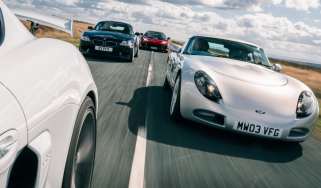Snetterton Track Days - Circuit in detail
We explain how to get the right lines at Snetterton
Riches CornerThis is yet another sequence that is quicker than it looks at first and which goes on for longer than you think. The idea is to miss what looks like a first apex by about half a car’s width and aim for one a little further round the corner, remembering to carry as much speed through the first part as possible. Unfortunately, there are two problems here. The bumps in the braking area can really unsettle the car and if you try and carry that extra speed with the car out of balance you slither wide towards the dirty part of the track and towards the cabbage patch straight ahead. And if you are tempted to edge too close to the kerb too soon and make an apex too early, the car will begin to wash out in the middle part of the corner, heading you at the exit kerb, rather than along it. Hop over that and you end up in the same cabbage patch – only a little further down. Riches is not difficult, but braking is the key, followed by a smooth entry. You must also remember to accelerate. It’s all too easy to get the line right but then wait too long for that second part before getting on the power.
Sear Corner It’s another one that goes on for longer than you first think and absolutely vital because a mistake here will cost you all the way down the long straight. In theory, it’s all straightforward and similar to Riches in that you aim a little further round the corner than you can see at first, then accelerate smoothly. In practice though, the complications are that seductive run-off area opposite the apex, and the tempting kerb to the right. How much of either you can use depends both on your car (how stiff of suspension) and the way you commit to the corner. There is also the initial temptation of the exit road ahead which was the entry to the old Norwich straight. All too easy to fix on this rather than the entry to the turn and leave your braking too late. And if you do have a big lock up, do not try and make the corner. Accept that you should keep it straight and bring the car to a halt. Attempting to make the turn risks hitting the marshal’s post or the earth bank.
The more recent complication is that area to the left of middle which has now been laid with extra Tarmac. Before that, it was the 1940’s concrete which was in surprisingly good health for something so old, but still far too rough for modern suspension. The circuit operators decided that since so many people were using it anyway and then bouncing into a spin which took them into the path of the pack, it was better to make it smoother. You can utilize a little of it but bear in mind that you still have to get back on the main road without having to lift when you get to the rough. You are now less likely to spin because the car is pointing more to the straight ahead, but the bouncing and beating will usually cost more in traction than is worth in corner radius.
As I said, much depends on your car, and how much grip it has, but you should always try to use as little of the extra road as possible. Best technique at first is to make a slightly later apex than you think is optimum, then bring it back towards you, safe in the knowledge that the area is there once you have overworked the front end. The kerb on the right is another tempting feature, but the cowpats that have been added are now too high for most cars. Aim to get as close to them as possible without running right over the top of the hump. Always remember that the length of the straight that follows means there is more to be lost by unbalancing the car and being late on the power.
The EssesAnother tempting escape road lies ahead of the entry to these, but there is nevertheless a lot of time to be made here. The trick is to judge just how fast you can go through the left hander, such that you can make a neat and tidy job of the right. One thing is certain; you cannot go as fast as is possible through the first left, but because you have to lose some speed on the straight before starting the turn, most cars will stand gentle braking through this first part. The job is made slightly easier because there seems to be a lot of grip where you need it but it still demands care - as the speed bleeds away, the left front wheel progressively unloads and is prone to lock up. That’s the wheel which you will soon be needing to turn right.
There is also the problem of gears. All cars will be near flat out in top by the end of the straight, and although the left is still a quick corner, you do not really have time for a double shift in the distance between the exit of this and the tight right that follows. The options are to grab fourth (or whatever is the next one down) as you brake at the end of the straight, then turn and miss out third and shift straight to second for the right hander. Sequential gearboxes take out some of the risk, but it’s still better to go down one at first, then a gentle double shift once you have lost some more speed.
Alternatively, with an H-pattern shift, you can ignore the shift while braking at the end of the straight and change gently from fifth to second just before you turn. The problems are; leaving yourself insufficient time to find the correct gear for the right hander, or, a potential overrev of the engine by doing it too soon. Much depends on your car, the gear ratios and shift quality, but whichever way, you need to heel and toe in order to do this part neatly.
The right hand part of the Esses is almost as important as Sear, the corner which sends you down the straight because most cars can take the next two corners (The Bombhole and Coram) nearly flat – or at least without braking. The exit of the Esses is narrow and the kerb is rough so you simply must avoid running over the edge – hence the prime need for a neat, late corner entry, and the need to get the gears and braking sorted before that.
The Bomb HoleMore free time and a relatively early turn. The road falls away from the crown towards the outside from the mid point so in order to carry speed through and avoid slithering into oversteer after the apex, you need to steal as much track to the right as possible. There’s a drain cover in the kerb just near the apex and most cars will stand a couple of wheels over it but a lot depends on commitment. If you attack the corner and make an early turn, saying “I am going to put two wheels to the right of that,” the car digs in the two left side wheels and grips, and the weight lifts from the right hand pair which then floats over the kerb as if it wasn’t there. Lose commitment just as you turn and too much kerb will unsettle the car. You should work up to this and be careful. At least you can see almost the whole corner before you turn.
Bear in mind too, that the road levels out at the top of the rise on the exit and you can suddenly find yourself with another load of oversteer that you didn’t expect. If that happens, make the apex a little bit later next time and give yourself a touch more room on the exit. Either that, or go in more slowly.
Coram CurveTogether with the Bombhole, this is a great sequence, but you string the pair together and treat it as such, only if you get the Bombhole right. A better exit means you will be carrying that much more speed towards Coram, and because it’s very slightly uphill, probably in the next gear up. Work up to it – please - and decide if, or how much, you need to lift – but in many cars you can find the desire to touch the brake pedal disappears. The temptation is then to delay the turn in and open out the entry so that you can accelerate harder by the apex – like the text book says. The potential problem in doing that is twofold; the road crests and falls away to the left as you get there, and the track is dirty just where you need to turn.
You need to research carefully on the day, but usually it pays start easing across the road after you crest the rise which follows the Bombhole, then hug the right hand kerb through the middle part of Coram, gently squeezing on the power and allowing the car to run out towards the left only when you see the corner open up. The risk of turning early is the same as always, that it will send you wide before the car and the corner are ready. There’s a dirty off-camber outside part towards the exit too and that will then try and claim you, by which time you are going pretty fast. It is a very long corner so best to aim further round, ease gently over, hug the kerb, then release the car. Russell Bend A bit like The Esses, this is a fast turn followed by a slow one, but there is not quite so much room. Much depends on whether you are racing anybody, but you need to be decisive with the car. You have to brake hard because the exit from Coram is fast, then you dive smartly across the track to the right, aiming across the road to run along the kerb on the right. Then, brake again, but remember to look left as you do – remembering too that that the most important thing is to open out the entry to the second, left hand corner. Having attempted to do that, you must still be patient because turning too early for the left will simply run you onto the exit kerb and kick you wide – or worse - and at best this will slow you for the long uphill drag past the pits towards Riches. You must also make sure you have the correct gear engaged and be ready to power up smooth and early. As with the Esses, using as much of the right hander to set up an optimum for the left, is the real trick.
In a race situation, it’s unfortunate that some people see this as an overtaking spot. Unless the car in front has made an obvious mistake, it’s not and it always leads to contact. If you try and discourage them by keeping to the right in the first part, you run too far to the left for the entry to the second. If you keep to the left for the left hander, you run too far to the right on the exit, which is probably worse. In either case whoever is two places behind can gently select the correct gear, turn neat and late, get the drag up the hill and drive past the pair of you.



